Irina Tabakina
-
- New Concept Eliminating Crude Oil Spill Spread Maritime Reporter, May 2014 #10
A new method is available which purports to stop the spread of major oil spills in offshore areas. It involves a floating ring-like device called Protection Ring Offshore Environment (PROE) that encircles the drilling rig. It has a curtain suspended vertically from the ring bottom that is designed to retain the oil spill. PROE is self-propelled and is submersible, meaning it is able to ‘chase’ oil spills if necessary. When not in use it can be submerged 50-ft. below marine surface traffic. It may also be divided into several parts in case the spill accumulates in several areas. PROE was developed following the BP Macondo oil spill in the Gulf of Mexico.
The American Energy Investment Group, a Houston independent oil company, reports it is implementing PROE, the oil spill retainer system shown in Figure 1. American Energy is the developer and owner of the PROE patent, which was issued in 7.5 months.
PROE is assigned continuously to the rig during all drilling and completion operations. In the event of a blowout or other accident PROE is surfaced, the two ends are locked together to encircle the rig and the retainer curtain is deployed as shown in Figure 2. Set-up operations are estimated to require less than one hour. The azimuth thrusters provide the force necessary to move PROE into the correct position and maintain that location with the aid of GPS. Depending upon the circumference of the system and curtain height, PROE developers claim that it can contain in the order of about 2.5 to over 5 million barrels.(As published in the May 2014 edition of Maritime Reporter & Engineering News - http://magazines.marinelink.com/Magazines/MaritimeReporter)
-
- BOS Provides 2-5% Fuel Savings Maritime Reporter, May 2014 #10
With consistent results of 2-5% fuel savings, Keppel Offshore & Marine’s subsidiary Blue Ocean Solutions (BOS) said that it has proved that emulsified fuel can bring significant fuel savings adding to the well established NOx reduction, if done correctly. The patented BOS Emulsified Fuel System (EFS) is
-
- Mammoet: World’s Biggest Crawler Crane Installs Legs on Ship Maritime Reporter, May 2014 #52
Mammoet employed the LR13000, reported to be the biggest crawler crane in the world, to install four platform legs on Van Oord’s newest wind turbine installation vessel, Aeolus. In 12 days the giant crane was assembled at Lloyd Werft in Bremerhaven, Germany. The first of the four 87m long steel platform
-
- ALP Tugs Get Rolls-Royce Deck Equipment Maritime Reporter, May 2014 #52
Rolls-Royce won a $31.9m contract to deliver deck machinery for four ocean going tugs, designed by Ulstein Design & Solutions, for Dutch company ALP Maritime Services. The vessels will be constructed in Japan by Niigata Shipbuilding & Repair. The vessels are being developed for towing large structures like
-
- Traction and Control System for Tugboat Winches Maritime Reporter, May 2014 #53
For Damen Shipyards, Bosch Rexroth developed and engineered both the hydraulic and electrical systems for the winches of a new tugboat. The Damen ASD Tug 3212 is a newly designed tugboat for assistance activities at offshore LNG and oil terminals and open sea loading stations for the mining industry.
-
- Townsville Opts for a Liebherr LHM 420 Maritime Reporter, May 2014 #53
Australian-based Northern Stevedoring Services (NSS) placed an order for a Liebherr mobile harbor crane, type LHM 420, to operate on Berth 3 and 4 in the Port of Townsville, Queensland. The operations of the stevedoring company span all of regional Queensland’s major port facilities, providing the full
-
- WASSP Goes Wireless with New Remote Mapping System Maritime Reporter, May 2014 #55
Multi-beam sonar manufacturer WASSP Ltd . debuts its latest system – now for super yacht applications. WASSP-Wireless has been designed to address one of super yacht captains biggest concerns; underwater obstacle avoidance. Ideally suited to use when navigating in unknown waters or where marine charts lack
-
- Danelec’s 3G VDR Maritime Reporter, May 2014 #55
Danelec Marine introduced its third-generation marine Voyage Data Recorder (VDR), the Danelec DM100 VDR. The new unit fully complies with the new IMO VDR standard which comes into effect July 1, 2014. It also incorporates Danelec’s SoftWare Advanced Protection (SWAP) technology – a new approach to shipboard
-
- ABB Energy Management System Maritime Reporter, May 2014 #55
ABB won an order from Spanish ferry operator Baleària to supply energy management systems for one of its largest vessels. ABB’s advisory software will be installed onboard the ferry Martin i Soler, with options for additional vessels. The package supplied is envisioned to generate a more than 2% savings in
-
- Transas Liquid Cargo Handling Simulator Maritime Reporter, May 2014 #55
Transas Marine launched its new liquid cargo handling simulator LCHS 5000 TechSim LNG which reportedly is the first one in the market to boast ship-to-ship transfer functionality. The new Transas LCHS 5000 TechSim product line includes simulators for LNG tanker, LNG terminal and LPG carrier. Ship-to-ship
-
- Color LCD Radar from SI-TEX Maritime Reporter, May 2014 #55
SI-TEX Marine Electronics launched its new T-760 Series Radar, which offers features like touch screen control, AIS target tracking and standard MARPA (Mini Automatic Radar Plotting Aid). SI-TEX T-760 Series’ compact, slim case and vertically oriented, 7-inch (800X480 pixel) touchscreen color LCD display
-
- Martek: Network-Connected ECDIS Maritime Reporter, May 2014 #55
Martek Marine released its unique ECDIS offering to the market: iECDIS, which the company claims is the first model to integrate a GSM modem, offering automatic download and installation of charts, updates and notices to mariners. The GSM modem uses a mobile network signal to keep iECDIS up to date anywhere
-
 )
March 2024 - Marine Technology Reporter page: 4
)
March 2024 - Marine Technology Reporter page: 4, the majority of events have re-emerged Production Manager level or stronger; some have faded considerably, but more noticeably there seems to be an Irina Vasilets [email protected] entire generation of new events. Invariably when I’m at one event, it always seems there are 2 or 3 others going
-
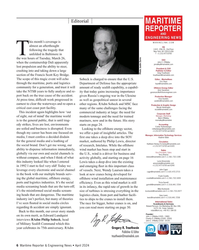 )
April 2024 - Maritime Reporter and Engineering News page: 6
)
April 2024 - Maritime Reporter and Engineering News page: 6importance [email protected] port back on the true cause of the accident. given Russia’s ongoing war in the Ukraine Production Manager Irina Vasilets At press time, dif? cult work progressed in as well as geopolitical unrest in several [email protected] earnest to clear the waterways
-
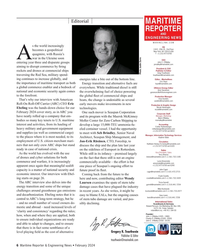 )
February 2024 - Maritime Reporter and Engineering News page: 6
)
February 2024 - Maritime Reporter and Engineering News page: 6the overwhelming fuel of choice powering [email protected] to the forefront. the global ? eet of commercial ships and Production Manager Irina Vasilets That’s why our interview with American boats, the change is undeniable as several [email protected] Roll-On Roll-Off Carrier (ARC)
-
 )
January 2024 - Marine Technology Reporter page: 4
)
January 2024 - Marine Technology Reporter page: 4payload bay. In fact, “The sky’s the limit in terms of payloads that can be brought into the vehicle” is how Ann Stevens, Production Manager Irina Vasilets Vice President, Boeing Maritime & Intelligence Systems, said it in our recent interview [email protected] which starts on page 22. But
-
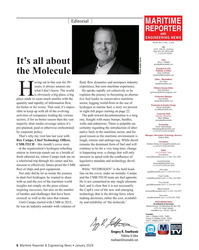 )
January 2024 - Maritime Reporter and Engineering News page: 6
)
January 2024 - Maritime Reporter and Engineering News page: 6yet cohesively as he [email protected] His obviously a big place, a big explains the journey to becoming an alterna- Production Manager Irina Vasilets place made to seem much smaller with the tive fuel leader in conservative maritime [email protected] quantity and rapidity of information
-
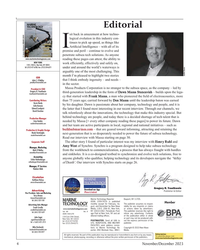 )
November 2023 - Marine Technology Reporter page: 4
)
November 2023 - Marine Technology Reporter page: 4that make this industry special. But behind technology are people, and today there is a decided shortage of tech talent that is Production Manager Irina Vasilets needed by Massa [+ every other company reading these pages] to power its future. Dawn [email protected] and her team are active participants
-
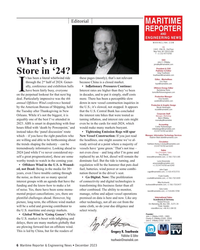 )
December 2023 - Maritime Reporter and Engineering News page: 6
)
December 2023 - Maritime Reporter and Engineering News page: 6they’ve been [email protected] on the perpetual lookout for that next big in decades, and to put it simply, stuff costs Production Manager Irina Vasilets deal. Particularly impressive was the 4th more. There has been a perceptible slow [email protected] annual Offshore Wind conference
-
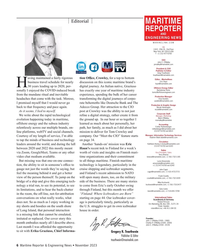 )
November 2023 - Maritime Reporter and Engineering News page: 6
)
November 2023 - Maritime Reporter and Engineering News page: 6of maritime industry [email protected] from the mundane ritual and inevitable experience, spending the bulk of her career Production Manager Irina Vasilets headaches that come with the task. Moreso, transforming the digital journeys of corpo- [email protected] I promised myself that I
-
 )
September 2023 - Marine Technology Reporter page: 4
)
September 2023 - Marine Technology Reporter page: 4she takes an inside out look at a tech Production Manager sector near and dear to nearly everyone reading these pages: battery technology, starting on Irina Vasilets page 40. The past few years have seen leaps and bounds in battery technology, a boon for [email protected] all who design, build, own
-
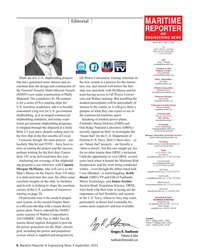 )
September 2023 - Maritime Reporter and Engineering News page: 6
)
September 2023 - Maritime Reporter and Engineering News page: 6, with McManus and his [email protected] (NSMV) now under construction at Philly team having access to GE Power Conver- Production Manager Irina Vasilets Shipyard. The cumulative $1.5B contract sion and Wabtec training. But installing the [email protected] is for a series of ? ve training
-
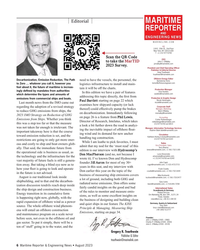 )
August 2023 - Maritime Reporter and Engineering News page: 6
)
August 2023 - Maritime Reporter and Engineering News page: 6and main- feel about it, the future of maritime is increas- tain it will be off the charts. Production Manager ingly de? ned by mandates from authorities Irina Vasilets In this edition we have a pair of features [email protected] which determine the types and amounts of addressing this topic directly
-
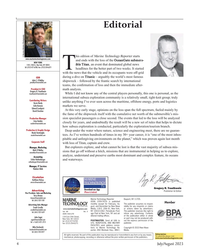 )
July 2023 - Marine Technology Reporter page: 4
)
July 2023 - Marine Technology Reporter page: 4net worth of the submersible’s mis- sion specialist passengers a close second. The events that led to the loss will be analyzed Production Manager Irina Vasilets closely for years, and undoubtedly the result will be a new set of rules that helps to dictate [email protected] how subsea exploration
-
 )
June 2023 - Maritime Reporter and Engineering News page: 6
)
June 2023 - Maritime Reporter and Engineering News page: 6among maritime leadership, confer- code above. ences and discussion, and June 25, 2023 This month’s cover story is an interview Production Manager Irina Vasilets will again mark the of? cial “Day of the with Garry Noonan, Director, Innovation, [email protected] Seafarer” as designated by the
-
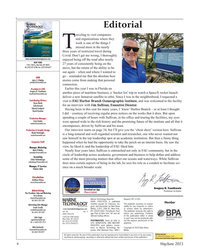 )
May 2023 - Marine Technology Reporter page: 4
)
May 2023 - Marine Technology Reporter page: 4on the works that it does. But upon spending a couple of hours with Sullivan, in his of? ce and touring the facilities, my eyes Production Manager Irina Vasilets were opened wide to the rich history and the promising future of the institute and all that it [email protected] encompasses, driven
-
 )
May 2023 - Maritime Reporter and Engineering News page: 6
)
May 2023 - Maritime Reporter and Engineering News page: 6fence, you a conventional vessel of the same type and must admit that, at the very size, and as of this writing the real-world Production Manager Irina Vasilets N least, it is fascinating to sit back data continues to come in for analysis by [email protected] and watch the continued evolution
-
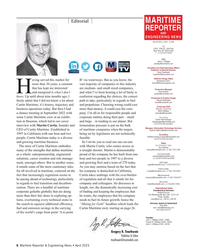 )
April 2023 - Maritime Reporter and Engineering News page: 6
)
April 2023 - Maritime Reporter and Engineering News page: 630 years, a constant vast majority of companies in this industry that has kept me interested are medium- and small-sized companies, Production Manager Irina Vasilets H and energized is what , don’t and what I’ve been hearing a lot of lately is [email protected] know. Up until about nine months
-
 )
March 2023 - Marine Technology Reporter page: 4
)
March 2023 - Marine Technology Reporter page: 4the explosion that took out the Nord Stream pipeline, protection of critical underwater infrastructure … from pipelines to com- Production Manager Irina Vasilets munications cables … has come to the fore. [email protected] • Offshore Energy: Sanctions on Russia following the invasion coupled with
-
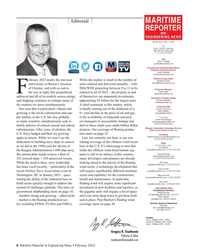 )
February 2023 - Maritime Reporter and Engineering News page: 6
)
February 2023 - Maritime Reporter and Engineering News page: 6invasion units ordered and delivered annually – with of Ukraine, and with no end to IMA/WER projecting between 9 to 11 to be Production Manager Irina Vasilets F the war in sight, this geopolitical ordered in all of 2023 – the projects in and [email protected] upheaval and all of its tendrils
-
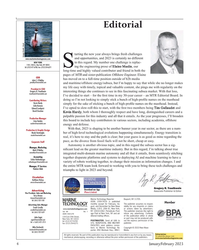 )
January 2023 - Marine Technology Reporter page: 4
)
January 2023 - Marine Technology Reporter page: 4. As the year progresses, I’ll broaden Production Manager this board to include key contributors in various sectors, including academia, offshore Irina Vasilets [email protected] energy and defense. With that, 2023 is shaping to be another banner year in our sector, as there are a num- Production
-
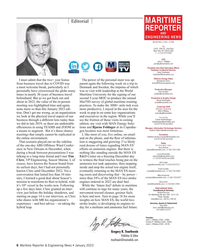 )
January 2023 - Maritime Reporter and Engineering News page: 6
)
January 2023 - Maritime Reporter and Engineering News page: 6as I Denmark and Sweden, the impetus of which Production Manager personally have crisscrossed the globe many was to visit with leadership at the World Irina Vasilets [email protected] times in nearly 30 years of business travel Maritime University for the signing of our Production & Graphic Design befor
-
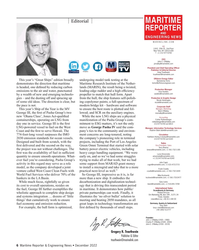 )
December 2022 - Maritime Reporter and Engineering News page: 6
)
December 2022 - Maritime Reporter and Engineering News page: 6lands (MARIN), the result being a twisted, Production Manager emissions to the air and water, punctuated leading-edge rudder and a high ef? ciency Irina Vasilets [email protected] by a wealth of new and emerging technolo- propeller to match that hull form. Apart Production & Graphic Design gies
-
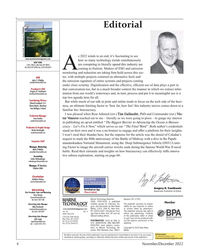 )
November 2022 - Marine Technology Reporter page: 4
)
November 2022 - Marine Technology Reporter page: 4Gallaudet, PhD and Commander (ret.) Vic- Production Manager tor Vescovo reached out to me – literally as we were going to press – to gauge my interest Irina Vasilets [email protected] in publishing an op/ed entitled “The Biggest Barrier to Advancing the Ocean is Bureau- cracy – Let’s Fix it Now,”
-
 )
November 2022 - Maritime Reporter and Engineering News page: 6
)
November 2022 - Maritime Reporter and Engineering News page: 6and fairly Baack offers some salient pieces of advice Production Manager stiff headwinds, led by in? ation growing for those mulling alternative fuels. Irina Vasilets [email protected] globally, continued geopolitical con? ict A niche yet interesting market to watch Production & Graphic Design courtesy
-
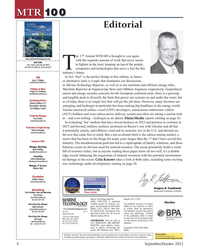 )
September 2022 - Marine Technology Reporter page: 4
)
September 2022 - Marine Technology Reporter page: 4providers are taking a serious look Production Manager at – and even trailing – hydrogen as an option, Elaine Maslin reports starting on page 42. Irina Vasilets [email protected] In evaluating ‘hot’ markets that have driven business in 2022 and promise to continue in 2023 and beyond, military
